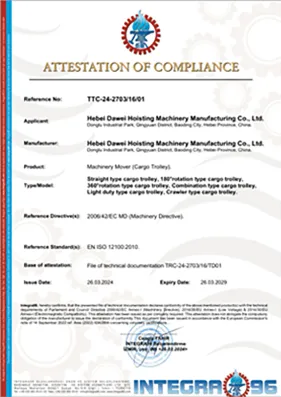portal crane
Understanding Portal Cranes Essential Machinery in Construction and Industry
Portal cranes are an integral part of modern construction and industrial operations. These versatile machines are designed to lift and move heavy loads efficiently, making them essential for various applications, including shipping yards, construction sites, and manufacturing facilities. By exploring the structure, functionality, and applications of portal cranes, we can appreciate their significance in meeting the demands of today's industrial landscape.
Structure of Portal Cranes
Portal cranes are characterized by their unique design, consisting of a horizontal beam known as the girder, supported by two vertical legs that rest on the ground or rails. This design allows the crane to straddle the load, enabling it to lift and move items across a designated area. Most portal cranes feature wheels that facilitate movement along a fixed path, enhancing their operational flexibility.
The primary components of a portal crane include
1. The Girder This is usually made from high-strength steel and is the horizontal beam that supports the lifting mechanism. The girder can be designed in different shapes and lengths to accommodate specific lifting requirements.
2. The Legs The vertical supports of the crane provide stability and strength. They are often designed to bear heavy loads while minimizing sway and vibration during operation.
3. The Hoisting System This system may include a winch, hoist, or other lifting mechanisms that can elevate and lower the load. The choice of system depends on the weight and type of materials being moved.
4. Control Systems Modern portal cranes are equipped with advanced control systems that allow operators to manage lifting and movement operations with precision, often using remote controls or computer systems.
Functionality of Portal Cranes
Portal cranes operate similarly to other types of cranes but offer unique advantages due to their structure. They are particularly effective in areas where space is limited and precision is crucial. Their ability to move along predefined paths enhances their efficiency, as they can be positioned exactly where needed without requiring a complex setup.
One of the key functionalities of portal cranes is their capacity for multitasking
. They can handle various operations, such as stacking containers in shipping yards, moving large materials in manufacturing plants, or assisting in construction projects. This versatility makes them invaluable assets in meeting the diverse requirements of industries.portal crane

Applications of Portal Cranes
The applications of portal cranes are vast and varied. Here are some common areas where these machines are employed
1. Shipping and Ports Portal cranes play a crucial role in transferring containers from ships to docks and vice versa. Their ability to straddle multiple containers allows for quick loading and unloading operations, significantly reducing port turnaround times.
2. Construction Sites In construction, portal cranes are used to lift heavy materials such as steel beams, concrete blocks, and equipment. Their ability to move loads over obstacles makes them ideal for urban construction projects where space is often at a premium.
3. Manufacturing Facilities In factories, portal cranes are employed to move raw materials and finished products along assembly lines. Their precise controls and strength make them suitable for heavy manufacturing tasks.
4. Mining Operations Portal cranes are also used in mining to transport large loads of ore and equipment. Their ability to operate in rugged terrains makes them a good choice for mining operations.
Safety and Efficiency
Safety is a paramount concern when operating portal cranes. Operators must be trained and certified to ensure the safe handling of loads. Modern portal cranes are equipped with safety features such as overload sensors, emergency stop buttons, and automatic braking systems to prevent accidents.
In addition, many companies are now incorporating technology such as telematics and IoT (Internet of Things) to monitor crane performance and optimize efficiency. These advancements allow for predictive maintenance, ensuring cranes are serviced before issues arise, thereby reducing downtime and enhancing productivity.
Conclusion
Portal cranes are vital machinery in various industries, providing the strength, flexibility, and efficiency required for heavy lifting and transportation tasks. Their unique design and capabilities make them indispensable in shipping, construction, manufacturing, and mining. As technology continues to evolve, portal cranes will undoubtedly become even more efficient, safe, and integral to the global industrial landscape. Understanding their functionalities and applications helps us appreciate how they contribute to keeping our economies moving forward.
-
the-power-of-trolley-cargo-and-machinery-moving-solutionsNewsAug.22,2025
-
exploring-magnetic-lifting-devices-for-efficient-steel-plate-handlingNewsAug.22,2025
-
the-essential-guide-toportal-craneNewsAug.22,2025
-
enhancing-efficiency-in-permanent-magnetic-liftersNewsAug.22,2025
-
heavy-duty-machinery-movers-and-material-handling-solutionsNewsAug.22,2025
-
the-comprehensive-guide-to-adjustable-gantry-cranesNewsAug.22,2025
-
The Ultimate Guide to Heavy Machinery Moving EquipmentNewsAug.04,2025
